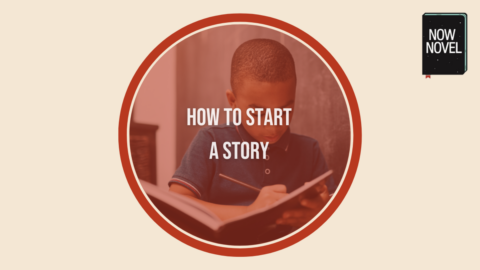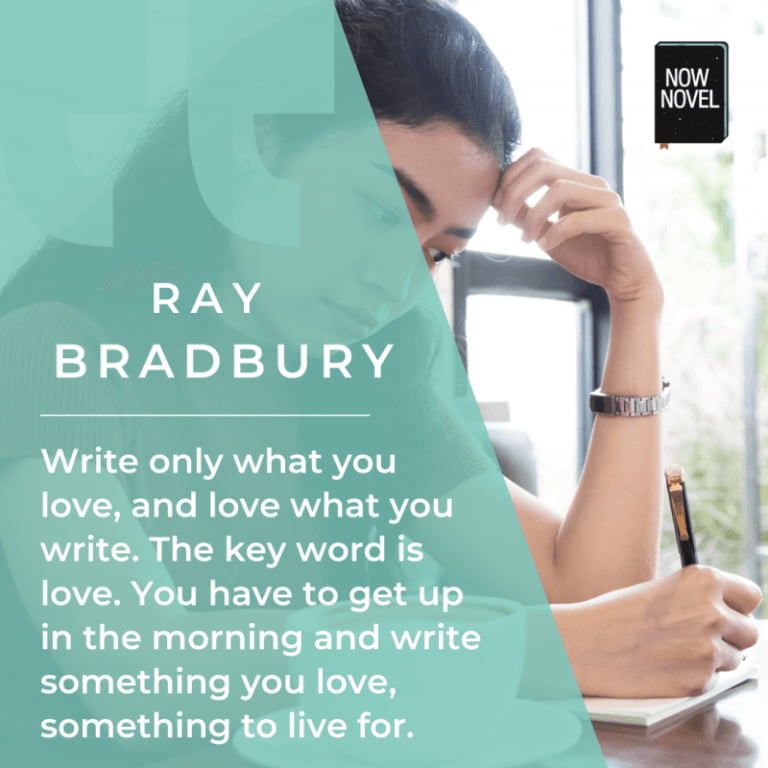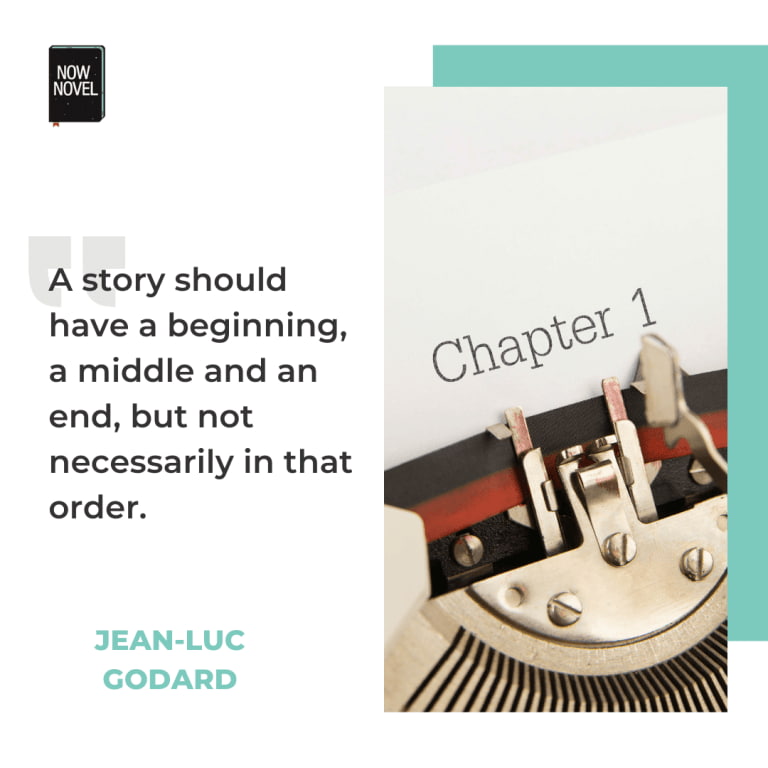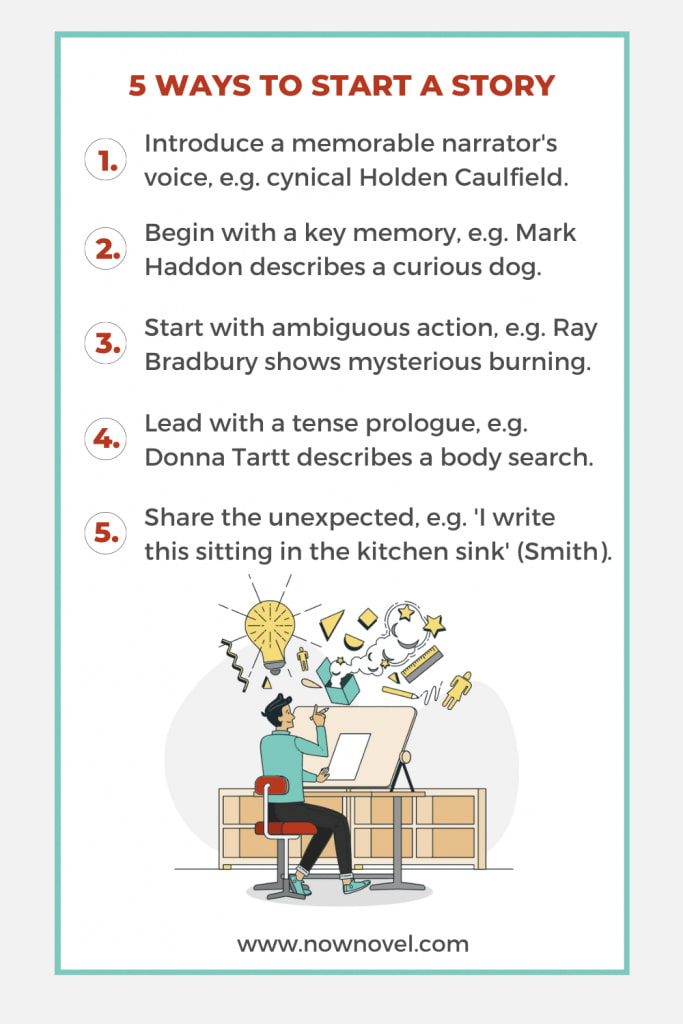Great authors show us there are many ways to start a story. You could begin a novel with a narrator/character introducing himself, like Salinger’s Holden Caufield or Dickens’ David Copperfield. Or you could begin in the thick of action, as Ray Bradbury’s does in his classic novel, Fahrenheit 451.
Have a read of the opening page or pages of authors you love, and explore how each starts a story, and notice how each is distinct from the other. A Stephen King novel will begin very differently from a Lianne Moriarty story, for example. Is there any bad writing? What makes it so, and what can you learn from it? Have they used active voice or passive voice? How does this change the opening? Compare a few to get a sense of the differences, and how each author’s distinct style comes through.
Before you begin, write down your story idea or your story structure. This doesn’t have to be a outline, but merely a few lines, stating the premise of that story.
Ways to start a story that engage your reader
These five types of story beginnings work:
- Introduce readers to a memorable narrator-protagonist
- Begin with crucial memories
- Start with ambiguous action
- Lead with a purposeful prologue
- Open with the unexpected
Watch the summary video on ways to begin stories now, then read discussion of the story beginnings below:
Introduce readers to a memorable narrator-protagonist
This is how to start a story about a character coming of age or grappling with internal conflict. These novels typically use first person narration. From the first line, the reader gets to know a characterful narrator. Decide whether you will use a first person narrator, or another point of view.
For example, Salinger’s Holden Caulfield in The Catcher in the Rye (1951) has a strong voice and clear, disaffected teen persona:
‘If you really want to hear about it, the first thing you’ll probably want to know is where I was born, and what my lousy childhood was like, and how my parents were occupied and all before they had me, and all that David Copperfield kind of crap, but I don’t feel like going into it, if you want to know the truth.’
J.D. Salinger, Catcher in the Rye (1951)
This opening is effective because we get a strong sense of the character’s personality in his terse use of curse words, slang and adjectives (‘crap’, ‘lousy’). Being addressed directly by the narrator creates a sense of closeness and familiarity. This effect is similar to Charlotte Bronte’s ‘Reader, I married him’ in Jane Eyre.
Another strong example of this story opening type, the protagonist/narrator introduction, is Vladimir Nabokov’s Lolita (1955). Nabokov begins his entire novel with his depraved anti-hero, Humbert Humbert, musing on the name of Lolita, the young object of his obsession:
Lolita, light of my life, fire of my loins. My sin, my soul. Lo-lee-ta: the tip of the tongue taking a trip of three steps down the palate to tap, at three, on the teeth. Lo. Lee. Ta.
Vladimir Nabokov, Lolita (1955)
Nabokov’s opening is strong because personality and character psychology are present from the first line.
When you start a story with your main character introducing themselves, remember to:
- Give them a distinctive voice: The grandiose language of Humbert Humbert fits the character, as do Salinger’s teen’s own cynical words.
- Show what matters to your character/narrator from the start: Holden values authenticity (‘if you want to know the truth’). We get a visceral sense of Humbert’s creepy obsession with Lolita through his rapture at even saying her name.
Begin with crucial memories
Often novels open with narrators recalling memories that are core to the plot. This can be part of the writing process and is of the ways to start a story that builds on a strong hook that is closely linked to your main plot.
Tweet This
Starting with memories requires knowing your character well, such as how their backstory guides their goals, motivations and potential conflicts.
This is especially common in novels where a single, unforgettable event casts its shadow over the rest of the book (e.g. the murder in a murder mystery).
Framing an event in your story through a character’s memory gives it weight. It’s also a crucial part of character development. When you begin your novel with your main character remembering an earlier scene, it’s thus important to choose the right scene. As novel writing coach Romy Sommer says:
An issue I see with a lot of beginner writers is they tend to write the backstory as the story itself… that backstory is usually you as the writer writing it for yourself so you can understand the characters.
‘Understanding Character Arcs: How to create characters’, webinar preview here.
Consider that you might be describing too much of a character’s everyday life. While some details are good, remember that doing so should also serve the story, but not bog it it down in too many details.
Choose a scene that shows a dilemma or choice, or a powerfully emotional experience that is bound to have consequences for your character.
For example, Mark Haddon’s The Curious Incident of the Dog in the Night-time opens with the 15-year-old narrator Christopher finding his neighbour’s murdered dog:
It was 7 minutes after midnight. The dog was lying on the grass in the middle of the lawn in front of Mrs Shears’ house. Its eyes were closed. It looked as if it was running on its side, the way dogs run when they think they’re chasing a cat in a dream. But the dog was not running or asleep. The dog was dead. There was a garden fork sticking out of the dog.
Mark Haddon, The Curious Incident of the Dog in the Night-time (2003)
Haddon’s opening is effective because it builds up to the revelation that the dog was killed violently. It’s effective because it raises questions we want answered.
When you begin with your narrator recalling a key memory, remember to:
- Choose a scene that immediately starts giving the reader keys to understanding: Haddon’s narrator proceeds to hug the bleeding dog, for example, so that we start to realise that Christopher is unusual in some way.
- Show the reader the memory: Haddon does not just say ‘Christopher found his neighbour’s dog, killed with a garden fork.’ We discover the dog through Christopher’s eyes, and this increases the scene’s impact.
Make a Strong Start to your Book
Join Kickstart your Novel and get professional feedback on your first three chapters and story synopsis, plus workbooks and videos.
Learn More
Start with ambiguous action
A little bit of mystery or confusion at the start of your novel can help to reel readers in.
At the same time, make sure your opening isn’t so mystifying that the reader bails in frustration.
Even if the purpose or reasons for your ambiguous opening aren’t clear at first, the action itself must sustain readers’ interest until there is more clarity.
Consider the opening of Ray Bradbury’s Fahrenheit 451:
It was a pleasure to burn.
It was a special pleasure to see things eaten, to see things blackened and changed. With the brass nozzle in his fists, with this great python spitting its venemous kerosene upon the world, the blood pounded in his head, and his hands were the hands of some amazing conductor playing all the symphonies of blazing and burning to bring down the tatters and charcoal ruins of history.’
Ray Bradbury, Fahrenheit 451 (1953)
The first sentence is ambiguous – who, or what, is burning? The next slowly fills in context: We learn a character is using kerosene to burn something, to destroy ‘history’, but we still don’t know what exactly. We only learn by the end of the paragraph that the character Montag is burning books.
This way of beginning a story is effective because Bradbury prolongs a mixture of suspense and confusion, yet the character’s action itself is clear.
If you begin a book with ambiguous, teasing action:
- Give the reader answers to at least one (or some) of the ‘5 w’s’. We might not immediately know who is doing the burning (or what they’re burning), but Bradbury gives us a strong why: Pleasure. The relish with which Montag burns the books is clear
- By the end of the first paragraph, give the reader a little more clarity, as Bradbury does
Lead with a purposeful prologue
‘Prologue’ literally means the ‘before word’. This separate introductory or prefatory section in a novel has several uses:
- Giving broad historical context that paves the way for the main story
- Showing a scene or event preceding the main narrative, whose consequences ripple through the following story
Donna Tartt uses the second type of prologue to excellent effect in her mystery novel The Secret History. Her prologue tells us that a character is murdered, that the narrator is somehow complicit, and that he will narrate the events that led up to the murder in the coming narrative.
This teaser makes it clear that motive, rather than identity, is the main mystery behind the killing.
Tartt’s prologue wastes no time in revealing key information that shapes our expectations for the main story:
The snow in the mountains was melting and Bunny had been dead for several weeks before we came to understand the gravity of our situation. He’d been dead for ten days before they found him, you know.
Donna Tartt, The Secret History (1992).
By immediately framing the story around Bunny’s murder and its aftermath, Tartt’s prologue directs our attention to the ground the coming story will cover. Not the fact of Bunny’s death but the swirl of events that spin out from this crime. It marks out a path into reading and making sense of the story.
Do you want to include a prologue in your book? Ask:
Do the events in the first part of your book need telling explaining prior events?
If yes, why?
In Tartt’s case, giving away key events in the prologue is smart, structurally. Because the identity of the murder victim (and at least one person responsible) is revealed early, the main narrative of the story is free to focus on character motivations and consequences and not just crime-solving.
Would your story flow better if you told earlier events via character flashbacks or a prologue?
Try writing a scene as a prologue, then write the same scene as a flashback. Which fits the scene better?
If you’re unsure how to start your novel, our writing coaches will help you get on track.
Open with the unexpected
The most memorable story openings surprise us and make us pause for a moment.
Take Bradbury’s beginning to Fahrenheit 451 above, ‘It was a pleasure to burn.’ It’s unexpected.
This is partially because of its inner contradiction. We know that getting a burn from a hot plate is painful, and the idea of pleasure is thus surprising.
The ambiguity of ‘it’ means we don’t know initially whether the narrator is describing an odd pleasure in burning himself or burning something else.
Examples from famous books reveal this has always been one of the popular ways to start a story. For example, Dodie Smith opens I Capture the Castle (1949):
‘I write this sitting in the kitchen sink.’
The narrator Cassandra’s choice of sitting place is unusual, intriguing us to read the next sentence. Whichever way you choose to begin your novel, getting the reader to read the second sentence is the first, crucial feat.
Start your own novel now: brainstorm story themes, settings and characters and get helpful feedback from the Now Novel community.





46 replies on “5 ways to start a story: Choosing a bold beginning”
I feel you have made some excellent choices to illustrate the point of today’s lesson. Each extract is a finely crafted piece of flash fiction as it stands.
Glad you enjoyed the choices, Bob (and thanks for sharing on Twitter).
looking for a way to start my Wattpad story besides starting it with dialougue
Same lol
cool
Thank you for reading the blog 🙂
This is really interesting thanks <3
It’s a pleasure, Akane-chan, thanks for reading our blog!
Me, deciding how to start my story, brough me here. This gave an idea on how I would want start it. Thanks.
I’m glad to hear that, Daniel! It’s our pleasure, thanks for reading our articles. Good luck with your story.
How do I introduce a death flashback at the beginning of my story???
Hi Karthik, thank you for asking. If it’s a death flashback would that mean your viewpoint character is remembering their death from the afterlife? I’d suggest starting just before the event leading to their death so that the scene is already at a high point of tension. Good luck! We have some advice on writing flashbacks here: https://www.nownovel.com/blog/incorporate-flashbacks-into-a-story/
I’m writing a story where the female lead is posing as a male at this all boy’s school, where he missing father used to attend. I’m unsure if I should start with a history of the school, he family life and motives, a group of males figuring her out or a point in the story where said males already know of her true identity. Any tips?
Hi Eiseley, I would say starting with a high-stakes, high-tension moment (your protagonist’s identity being found out, for example) would be a good beginning – you can always circle back to how it is they came to be attending the school in disguise.
[…] http://www.education.com/lesson-plan/finding-the-moral/http://www.mensaforkids.org/teach/lesson-plans/the-art-of-storytelling/http://www.literacyideas.com/latest/2018/2/3/5-fun-ways-to-use-fables-in-your-literacy-lessonshttp://www.teachingenglish.org.uk/article/kids-storieshttps://www.nownovel.com/blog/ways-to-start-story-examples/ […]
“it was too late “she sigh. the act was already done .. do not know how to start this short story and include this sentence
Hi Shebekie, you’re getting there! I’d suggest editing to: ‘It was too late. She sighed – the deed was already done.’ To continue it, you could tease out the mystery surrounding the nature of the character’s deed further. For example, you could imply potential consequences (e.g. ‘Now she’d have to tell the others’).
Hi I’m trying to find out how to correctly start my sorry without boring the audience. The story is about a teenage boy transferring to a new high school which he finds a girl that is unloving and careless so he’s trying to win her heart over and prove that she can truly be loved.
Hi Darhnell, thank you for sharing that.
I would say you have a good starting point in your MC transferring to a new high school, as that’s a situation that would likely be full of surprise, change, trepidation, anxiety, new friends (or new foes), etc. So showing the first time your character enters the new school, for example, or how he feels in the lead-up to arrival, would be one way to start.
Or you could start in medias res (in the middle of the action) with a significant moment during his first day at the new school. For example, his first interaction with the girl, circling back to how he got there later in the chapter. These are just some ideas. I hope this helps!
Hi, nice tips. I was wondering how to start a short story for 2 boys named Luke and Max stranded in their canoes. They were set on a research expedition on the animals in Antarctica but they got lost and couldn’t find anything. They are trying to head home by following the North star so they could reach their lab in Argentina. Pls, help me start. I was going with the idea of saying. “It was 7 minutes after midnight in Antarctica. The water swayed from ice-burg to ice-burg leaving a sparkling coat. Luke and Max were vigorously paddling their canoes towards the north start hoping at any moment they could get back to their warm and cpzy lab back in Argentina”
Hi Bob, thank you for the feedback and for sharing your idea. Not being much of an astronomer myself I had to check regarding Polaris (the North Star) and apparently it is only visible under certain conditions south of the equator, so perhaps they’d need another navigational technique. A compass, perhaps?
If it is after midnight and they are that far south, hypothermia would be a major risk, so perhaps the boys don’t get that far south to begin with? You can of course bend the rules of physics and geography in fiction if you want to tell a fantastical story. There are a few typos (‘ice-burg’ for ‘iceberg’, ‘start’ for ‘star’ and so forth) but other than that it is a suspenseful situation for an opening. Some readers may question the science behind some of the details mentioned though.
Beginning in the middle of the action is interesting, just make sure the exposition of the story continues to explain why the boys are there in the first place. I hope this is helpful!
Wow so good ways to start a story
Thank you, Priyank. Good luck with your own!
im writing a creative story about an orphan girl and im trying to craete the story but i need help any chance you would help me
Hi Ivokjuca, happily! What do you need help with? Please feel free to mail us at [email protected] too with your challenge.
Thank you very much for the tips… i was wondering how to start my story which i am writing about an incident of my life which is a complete secret to date. i hope this will help me start my piece
Hi Rashmi, it’s a pleasure! Good luck with starting your story and developing it further.
Thank you very much for the tips. it is really very helpful for me. Keep Sharing.
Thank you for your feedback, Anu! We will do so.
[…] https://www.nownovel.com/blog/ways-to-start-story-examples/ […]
Thanks a lot for this. It helped me a lot.
It’s a pleasure, thank you for reading our articles.
Hi there! I am a young writer (13 to be exact), and I am brainstorming for a way to start my first novel. Can you perhaps give me some inspiration?
My novel is about three teenagers: Claire Minch, Samuel Ploy, and Sheila Crover. They live on a technologically advanced planet called Gyn, where the whole world’s population receives warnings from their future selves, or so they thought. In the end, I want it to state that instead of being warned by their future selves, the warnings are given by a Krewd (Demon) who has been leading them down the wrong path all along.
Please give me some advice. I have been all over the internet, bt nothing really sparked my imagination for the start of my novel.
Hi Anani, thank you for sharing that (it’s great you’re working hard on your writing by the way).
It’s an interesting idea. Given the interesting warning system you described, starting with one of the warnings could be one way to go. How are the warnings broadcast, and is there a schedule (e.g. do they know when the warnings are going to come, do they each get their warnings at the same time, and is it transmitted via tech or something they just hear?).
Keep asking questions, as you will know best what to choose. Are you looking for inspiration for any particular character or part of the story?
I hope the questions I asked help!
It’s always good to read and learn about stories
That it is, Mark 🙂 Thanks for reading our blog.
I am trying to write a thriller and romantic story pls help me
Hi Nish, with pleasure. What aspect of the story would you like help with? Do you have a firm story idea developed already? What about it is giving you trouble? You can find all our articles on writing romantic stories here.
This tips were quite helpful. Though, I still have a few holes on how to start my story.
Thank you for sharing that, Georgina. What are there holes around? You might find this article on how to avoid plot holes helpful.
As a student and teacher of English, I had to read, write and teach a number of stories. I learnt about the essential plot parts, techniques, character-development and so on.
The problem with me, while writing my own stories, I forgot mostly what I had learnt about story writing. I thought I was writing some really interesting stories though.
I started sending my stories to online, offline magazines, started participating in Flash Fiction Contests where I had my fellow writers commenting on my stories. I felt that I could consider myself to be a competent writer. But aren’t competent, capable writers supposed to have name and fame? Aren’t they supposed to be rich?
Even after having written over 500 short stories, forget about being rich, I wasn’t even earning a penny?
If I don’t get published, if I don’t get paid by writing, am I going to die an unfulfilled writer? These questions have become paramount in my mind lately. In my early 60s, I am not sure any more if writing is the thing for someone like me with very little economic freedom. Writing is reaching a point in my retired life when it is not sheer fun anymore.
My question to you is, would you still advise me to continue writing? Do you still think that there is a flicker of light at the end of the tunnel?
Stay blessed.
Hi Rathin, thank you for sharing this personal account of your writing path. I would say it depends on your aims. To make money from writing, it is crucial to approach it as a business and do careful market research, invest time in marketing your work, and use every available resource (social media, Amazon author pages (if you’re listing work there), Goodreads, and other places such as book fairs to build an audience interested in what you have to say.
This being said, writing is lucrative for very few writers and many support their writing with side hustles. Fame and riches are goals beyond one’s immediate control, there being so many variable factors involved in earning them, so I would always advocate writing for passion and the pleasure of creation and communication above money or fame.
It is challenging to have ‘very little economic freedom’ as you describe, as that makes writing more of a luxury if it isn’t contributing income. Approaching it as a pleasure and an escape into creation rather than putting financial pressure on the process may be best for keeping the joy of it alive, though (one can do commercial writing such as copywriting for money as it tends to pay better per hours invested). I hope this is helpful, it is of course a highly subjective perspective.
This was so helpfull. And i think i know how i can start my story! But how will i switch from a prologue to a chapter
Hi Cliffton, thank you for sharing your kind feedback. I’m glad you have an idea about how you want to start your story. That’s a broad question, what information do you plan to share in your prologue? Many effective prologues do a little worldbuilding while creating a little curiosity, then the first chapter picks up with immediate, scene-level action or a character’s voice (the prologue giving more of a general sense of a situation, place or mood). There are so many ways to use a prologue – the main thing is to make it as interesting and curiosity rousing as chapter 1. Here’s something I wrote on prologues you may find useful.
Thanks for this useful tips.
Thanks George, glad you found them useful.